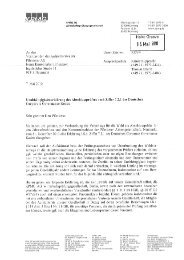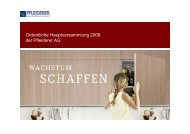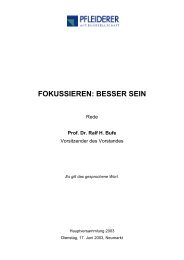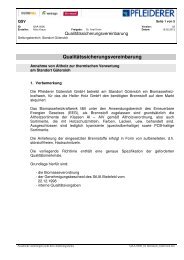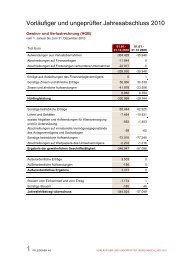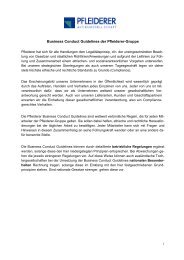PDF, 3.2 MB - Pfleiderer AG
PDF, 3.2 MB - Pfleiderer AG
PDF, 3.2 MB - Pfleiderer AG
You also want an ePaper? Increase the reach of your titles
YUMPU automatically turns print PDFs into web optimized ePapers that Google loves.
3. Derivative financial<br />
instruments<br />
4. Costs of rasing<br />
capital<br />
5. Stock options<br />
6. Foreign currency<br />
translation<br />
7. Accounting for<br />
and amortization<br />
of goodwill<br />
There is no binding approach under HGB to accounting for and the valuation of derivative financial<br />
instruments, so that they are valued taking into account the historical cost, realization and<br />
prudence principles.<br />
US-GAAP, on the other hand, requires all original and derivative financial instruments to be measured<br />
at fair value. Under certain restrictive conditions, US-GAAP requires that hedging be recognized<br />
in the balance sheet, with the consequence that fluctuations in the fair value of financial<br />
instruments used for hedging purposes are not recognized directly as expense or income, but<br />
are deferred temporarily under equity. The criteria for recognition of hedging in the balance sheet<br />
depend on the nature of the hedged item and the hedging instrument. If the criteria for recognition<br />
of hedging in the balance sheet are not fulfilled, fluctuations in the fair value of derivatives<br />
must be recognized as expense or income in the period in which they occur.<br />
Under German law, costs of raising capital must be recognized as expense and may not be offset<br />
against the proceeds of increases in capital. Under US-GAAP, costs of raising equity, such as<br />
issuing costs incurred in conjunction with an initial public offering, less the related income tax<br />
effects, are deducted from the gross proceeds of the funds raised, thus reducing the additional<br />
paid-in capital.<br />
No prevailing opinion has developed to date in Germany on the treatment of the issuance of<br />
stock options to employees. Under US-GAAP, stock options are mainly dealt with in APB 25 and<br />
SFAS 123. Under APB 25, stock options are valued in accordance with their intrinsic value and<br />
under SFAS 123 in accordance with their fair value. The Company applies APB 25 for accounting<br />
for stock options, in accordance with which the intrinsic value is based on the difference between<br />
the exercise price and the higher current market price.<br />
Whereas under HGB, non-hedged foreign currency receivables and liabilities are valued at the<br />
exchange rate on the transaction date or the less favorable rate in each case as of the balance<br />
sheet date, US-GAAP requires in accordance with SFAS 52 (Foreign Currency Translation) that<br />
all foreign currency receivables and liabilities are valued at the closing rate as of the balance sheet<br />
date, with the consequence that unrealized exchange gains are also recognized as income.<br />
Under German commercial law, goodwill acquired for a consideration must be capitalized and<br />
amortized over its expected useful life. If the goodwill results from first-time consolidation, it<br />
is offset in full against equity in the year in which it arises. Goodwill must be written down, for<br />
instance, if the future earnings situation is not expected to be positive. An impairment loss is<br />
regarded as justified under the aspect of the prudence principle.<br />
112





